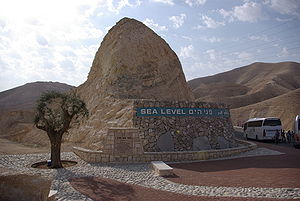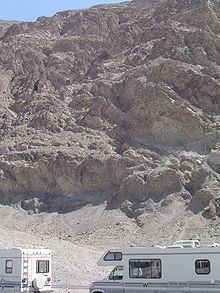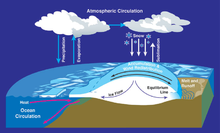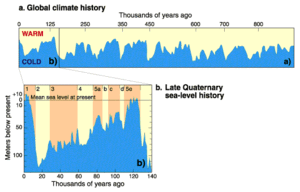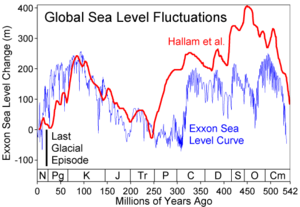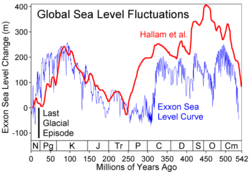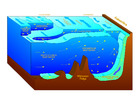- Sea level
-
For the sea level change associated with the current episode of global warming, see current sea level rise.For other uses, see Sea level (disambiguation).
Mean sea level (MSL) is a measure of the average height of the ocean's surface (such as the halfway point between the mean high tide and the mean low tide); used as a standard in reckoning land elevation.[1] MSL also plays an extremely important role in aviation, where standard sea level pressure is used as the measurement datum of altitude at flight levels.
Contents
Measurement
 Sea level measurements from 23 long tide gauge records in geologically stable environments show a rise of around 200 millimetres (7.9 in) during the 20th century (2 mm/year).[citation needed]
Sea level measurements from 23 long tide gauge records in geologically stable environments show a rise of around 200 millimetres (7.9 in) during the 20th century (2 mm/year).[citation needed]
To an operator of a tide gauge, MSL means the "still water level"—the level of the sea with motions such as wind waves averaged out—averaged over a period of time such that changes in sea level, e.g., due to the tides, also get averaged out. One measures the values of MSL in respect to the land. Hence a change in MSL can result from a real change in sea level, or from a change in the height of the land on which the tide gauge operates.
In the UK, mean sea level has been measured at Newlyn in Cornwall and Liverpool for decades, by tide gauges to provide Ordnance Datum for the zero metres height on UK maps.
In France, the Marégraphe in Marseilles [1] measures continuously the sea level since 1883 and offers the longest collapsed data about the sea level. It is used for a part of continental Europe and main part of Africa as official sea level.
Satellite altimeters have been making precise measurements of sea level since the launch of TOPEX/Poseidon in 1992. A joint mission of NASA and CNES, TOPEX/Poseidon was followed by Jason-1 in 2001 and the Ocean Surface Topography Mission on the Jason-2 satellite in 2008.
Difficulties in utilization
To extend this definition far from the sea means comparing the local height of the mean sea surface with a "level" reference surface, or datum, called the geoid. In a state of rest or absence of external forces, the mean sea level would coincide with this geoid surface, being an equipotential surface of the Earth's gravitational field. In reality, due to currents, air pressure variations, temperature and salinity variations, etc., this does not occur, not even as a long term average. The location-dependent, but persistent in time, separation between mean sea level and the geoid is referred to as (stationary) ocean surface topography. It varies globally in a range of ± 2 m.
Traditionally, one had to process sea-level measurements to take into account the effect of the 228-month Metonic cycle and the 223-month eclipse cycle on the tides. Mean sea level is not constant over the surface of the Earth. For instance, mean sea level at the Pacific end of the Panama Canal stands 20 cm (7.9 in) higher than at the Atlantic end.
Sea level and dry land
Sea level sign (2/3 of the way up the cliff face) above Badwater Basin, Death Valley National Park, USA
Several terms are used to describe the changing relationships between sea level and dry land. When the term "relative" is used, it means change relative to a fixed point in the sediment pile. The term "eustatic" refers to global changes in sea level relative to a fixed point, such as the centre of the earth, for example as a result of melting ice-caps. The term "steric" refers to global changes in sea level due to thermal expansion and salinity variations. The term "isostatic" refers to changes in the level of the land relative to a fixed point in the earth, possibly due to thermal buoyancy or tectonic effects; it implies no change in the volume of water in the oceans. The melting of glaciers at the end of ice ages is one example of eustatic sea level rise. The subsidence of land due to the withdrawal of groundwater is an isostatic cause of relative sea level rise. Paleoclimatologists can track sea level by examining the rocks deposited along coasts that are very tectonically stable, like the east coast of North America. Areas like volcanic islands are experiencing relative sea level rise as a result of isostatic cooling of the rock which causes the land to sink.
On other planets that lack a liquid ocean, planetologists can calculate a "mean altitude" by averaging the heights of all points on the surface. This altitude, sometimes referred to as a "sea level", serves equivalently as a reference for the height of planetary features.
Sea level change
Local and eustatic sea level
Local mean sea level (LMSL) is defined as the height of the sea with respect to a land benchmark, averaged over a period of time (such as a month or a year) long enough that fluctuations caused by waves and tides are smoothed out. One must adjust perceived changes in LMSL to account for vertical movements of the land, which can be of the same order (mm/yr) as sea level changes. Some land movements occur because of isostatic adjustment of the mantle to the melting of ice sheets at the end of the last ice age. The weight of the ice sheet depresses the underlying land, and when the ice melts away the land slowly rebounds. Changes in ground-based ice volume also affect local and regional sea levels by the readjustment of the geoid and true polar wander. Atmospheric pressure, ocean currents and local ocean temperature changes can affect LMSL as well.
Eustatic change (as opposed to local change) results in an alteration to the global sea levels due to changes in either the volume of water in the world oceans or net changes in the volume of the ocean basins.[2]
A more recent theory as to why sea levels have varied so dramatically throughout geologic history is, in part, due to Isostatic Rebound. Part of this new theory states that as denser oceanic plate is subducted under less dense continental plate at a convergence plate boundary with a subduction zone, some of the oceanic plate is pulled downward briefly (geologically speaking) as the oceanic plate sinks into the Earth's Mantle. The Continental crust then bounces back up, restoring its previous position at equilibrium. Recent studies have suggested this was the case with the continent of Australia.
Short term and periodic changes
There are many factors which can produce short-term (a few minutes to 14 months) changes in sea level.
Periodic sea level changes Diurnal and semidiurnal astronomical tides 12–24 h P 0.2–10+ m Long-period tides Rotational variations (Chandler wobble) 14 month P Meteorological and oceanographic fluctuations Atmospheric pressure Hours to months –0.7 to 1.3 m Winds (storm surges) 1–5 days Up to 5 m Evaporation and precipitation (may also follow long-term pattern) Days to weeks Ocean surface topography (changes in water density and currents) Days to weeks Up to 1 m El Niño/southern oscillation 6 mo every 5–10 yr Up to 0.6 m Seasonal variations Seasonal water balance among oceans (Atlantic, Pacific, Indian) Seasonal variations in slope of water surface River runoff/floods 2 months 1 m Seasonal water density changes (temperature and salinity) 6 months 0.2 m Seiches Seiches (standing waves) Minutes to hours Up to 2 m Earthquakes Tsunamis (generate catastrophic long-period waves) Hours Up to 10 m Abrupt change in land level Minutes Up to 10 m Long term changes
Various factors affect the volume or mass of the ocean, leading to long-term changes in eustatic sea level. The primary influence is that of temperature on seawater density and the amounts of water in rivers, lakes, glaciers, polar ice caps and sea ice. Over much longer geological timescales, changes in the shape of the oceanic basins and in land/sea distribution will also affect sea level.
Observational and modelling studies of mass loss from glaciers and ice caps indicate a contribution to sea-level rise of 0.2 to 0.4 mm/yr averaged over the 20th century.
Glaciers and ice caps
Each year about 8 mm (0.3 inch) of water from the entire surface of the oceans falls into the Antarctica and Greenland ice sheets as snowfall. If no ice returned to the oceans, sea level would drop 8 mm every year. To a first approximation, the same amount of water appeared to return to the ocean in icebergs and from ice melting at the edges. Scientists previously had estimated which is greater, ice going in or coming out, called the mass balance, important because it causes changes in global sea level. High-precision gravimetry from satellites in low-noise flight has since determined Greenland is losing billions of tons per year, in accordance with loss estimates from ground measurement.
Ice shelves float on the surface of the sea and, if they melt, to first order they do not change sea level. Likewise, the melting of the northern polar ice cap which is composed of floating pack ice would not significantly contribute to rising sea levels. Because they are lower in salinity, however, their melting would cause a very small increase in sea levels, so small that it is generally neglected.
- Scientists previously lacked knowledge of changes in terrestrial storage of water. Surveying of water retention by soil absorption and by reservoirs outright ("impoundment") at just under the volume of Lake Superior agreed with a dam-building peak in the 1930s-1970s timespan. Such impoundment masked tens of millimetres of sea level rise in that span. ( Impact of Artificial Reservoir Water Impoundment on Global Sea Level. http://www.sciencemag.org/cgi/content/full/320/5873/212?rss=1. B. F. Chao,* Y. H. Wu, Y. S. Li).
- If small glaciers and polar ice caps on the margins of Greenland and the Antarctic Peninsula melt, the projected rise in sea level will be around 0.5 m. Melting of the Greenland ice sheet would produce 7.2 m of sea-level rise, and melting of the Antarctic ice sheet would produce 61.1 m of sea level rise.[3] The collapse of the grounded interior reservoir of the West Antarctic Ice Sheet would raise sea level by 5–6 m.[4]
- The snowline altitude is the altitude of the lowest elevation interval in which minimum annual snow cover exceeds 50%. This ranges from about 5,500 metres above sea-level at the equator down to sea level at about 70° N&S latitude, depending on regional temperature amelioration effects. Permafrost then appears at sea level and extends deeper below sea level polewards.
- As most of the Greenland and Antarctic ice sheets lie above the snowline and/or base of the permafrost zone, they cannot melt in a timeframe much less than several millennia; therefore it is likely that they will not, through melting, contribute significantly to sea level rise in the coming century. They can, however, do so through acceleration in flow and enhanced iceberg calving.
- Climate changes during the 20th century are estimated from modelling studies to have led to contributions of between –0.2 and 0.0 mm/yr from Antarctica (the results of increasing precipitation) and 0.0 to 0.1 mm/yr from Greenland (from changes in both precipitation and runoff).
- Estimates suggest that Greenland and Antarctica have contributed 0.0 to 0.5 mm/yr over the 20th century as a result of long-term adjustment to the end of the last ice age.
The current rise in sea level observed from tide gauges, of about 1.8 mm/yr, is within the estimate range from the combination of factors above[5] but active research continues in this field. The terrestrial storage term, thought to be highly uncertain, is no longer positive, and shown to be quite large.
Geological influences
At times during Earth's long history, the configuration of the continents and seafloor have changed due to plate tectonics. This affects global sea level by determining the depths of the ocean basins and how glacial-interglacial cycles distribute ice across the Earth.
The depth of the ocean basins is a function of the age of oceanic lithosphere: as lithosphere becomes older, it becomes denser and sinks. Therefore, a configuration with many small oceanic plates that rapidly recycle lithosphere will produce shallower ocean basins and (all other things being equal) higher sea levels. A configuration with fewer plates and more cold, dense oceanic lithosphere, on the other hand, will result in deeper ocean basins and lower sea levels.
When there were large amounts of continental crust near the poles, the rock record shows unusually low sea levels during ice ages, because there was lots of polar land mass upon which snow and ice could accumulate. During times when the land masses clustered around the equator, ice ages had much less effect on sea level.
Over most of geologic time, long-term sea level has been higher than today (see graph above). Only at the Permian-Triassic boundary ~250 million years ago was long-term sea level lower than today. Long term changes in sea level are the result of changes in the oceanic crust, with a downward trend expected to continue in the very long term.[6]
During the glacial/interglacial cycles over the past few million years, sea level has varied by somewhat more than a hundred metres. This is primarily due to the growth and decay of ice sheets (mostly in the northern hemisphere) with water evaporated from the sea.
The Mediterranean Basin's gradual growth as the Neotethys basin, begun in the Jurassic, did not suddenly affect ocean levels. While the Mediterranean was forming during the past 100 million years, the average ocean level was generally 200 metres above current levels. However, the largest known example of marine flooding was when the Atlantic breached the Strait of Gibraltar at the end of the Messinian Salinity Crisis about 5.2 million years ago. This restored Mediterranean sea levels at the sudden end of the period when that basin had dried up, apparently due to geologic forces in the area of the Strait.
Long-term causes Range of effect Vertical effect Change in volume of ocean basins Plate tectonics and seafloor spreading (plate divergence/convergence) and change in seafloor elevation (mid-ocean volcanism) Eustatic 0.01 mm/yr Marine sedimentation Eustatic < 0.01 mm/yr Change in mass of ocean water Melting or accumulation of continental ice Eustatic 10 mm/yr • Climate changes during the 20th century •• Antarctica (the results of increasing precipitation) Eustatic -0.2 to 0.0 mm/yr •• Greenland (from changes in both precipitation and runoff) Eustatic 0.0 to 0.1 mm/yr • Long-term adjustment to the end of the last ice age •• Greenland and Antarctica contribution over 20th century Eustatic 0.0 to 0.5 mm/yr Release of water from earth's interior Eustatic Release or accumulation of continental hydrologic reservoirs Eustatic Uplift or subsidence of Earth's surface (Isostasy) Thermal-isostasy (temperature/density changes in earth's interior) Local effect Glacio-isostasy (loading or unloading of ice) Local effect 10 mm/yr Hydro-isostasy (loading or unloading of water) Local effect Volcano-isostasy (magmatic extrusions) Local effect Sediment-isostasy (deposition and erosion of sediments) Local effect < 4 mm/yr Tectonic uplift/subsidence Vertical and horizontal motions of crust (in response to fault motions) Local effect 1–3 mm/yr Sediment compaction Sediment compression into denser matrix (particularly significant in and near river deltas) Local effect Loss of interstitial fluids (withdrawal of groundwater or oil) Local effect ≤ 55 mm/yr Earthquake-induced vibration Local effect Departure from geoid Shifts in hydrosphere, aesthenosphere, core-mantle interface Local effect Shifts in earth's rotation, axis of spin, and precession of equinox Eustatic External gravitational changes Eustatic Evaporation and precipitation (if due to a long-term pattern) Local effect Changes through geologic time
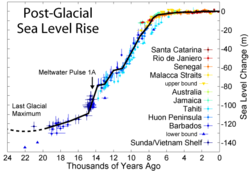 Sea level change since the end of the last glacial episode. Changes displayed in metres.
Sea level change since the end of the last glacial episode. Changes displayed in metres.
Sea level has changed over geologic time. As the graph shows, sea level today is very near the lowest level ever attained (the lowest level occurred at the Permian-Triassic boundary about 250 million years ago).
During the most recent ice age (at its maximum about 20,000 years ago) the world's sea level was about 130 m lower than today, due to the large amount of sea water that had evaporated and been deposited as snow and ice, mostly in the Laurentide ice sheet. The majority of this had melted by about 10,000 years ago.
Hundreds of similar glacial cycles have occurred throughout the Earth's history. Geologists who study the positions of coastal sediment deposits through time have noted dozens of similar basinward shifts of shorelines associated with a later recovery. This results in sedimentary cycles which in some cases can be correlated around the world with great confidence. This relatively new branch of geological science linking eustatic sea level to sedimentary deposits is called sequence stratigraphy.
The most up-to-date chronology of sea level change during the Phanerozoic shows the following long term trends:[7]
- Gradually rising sea level through the Cambrian
- Relatively stable sea level in the Ordovician, with a large drop associated with the end-Ordovician glaciation
- Relative stability at the lower level during the Silurian
- A gradual fall through the Devonian, continuing through the Mississippian to long-term low at the Mississippian/Pennsylvanian boundary
- A gradual rise until the start of the Permian, followed by a gentle decrease lasting until the Mesozoic.
Recent changes
Main article: Current sea level riseFor at least the last 100 years, sea level has been rising at an average rate of about 1.8 mm per year.[8] The majority of this rise can be attributed to the increase in temperature of the sea and the resulting thermal expansion of sea water. Additional contributions come from water sources on land such as melting snow and glaciers (see global warming).[9]
Aviation
Using pressure to measure altitude results in two other types of altitude. Distance above true or MSL (mean sea level) is the next best measurement to absolute. MSL altitude is the distance above where sea level would be if there were no land. If one knows the elevation of terrain, the distance above the ground is calculated by a simple subtraction.
An MSL altitude—called pressure altitude by pilots—is useful for predicting physiological responses in unpressurized aircraft (see hypoxia). It also correlates with engine, propeller, and wing performance, which all decrease in thinner air.
Pilots can estimate height above terrain with an altimeter set to a defined barometric pressure. Generally, the pressure used to set the altimeter is the barometric pressure that would exist at MSL in the region being flown over. This pressure is referred to as either QNH or "altimeter" and is transmitted to the pilot by radio from air traffic control (ATC) or an Automatic Terminal Information Service (ATIS). Since the terrain elevation is also referenced to MSL, the pilot can estimate height above ground by subtracting the terrain altitude from the altimeter reading. Aviation charts are divided into boxes and the maximum terrain altitude from MSL in each box is clearly indicated. Once above the transition altitude (see below), the altimeter is set to the international standard atmosphere (ISA) pressure at MSL which is 1013.2 HPa or 29.92 inHg.[10]
Flight level
MSL is useful for aircraft to avoid terrain, but at high enough altitudes, there is no terrain to avoid. Above that level, pilots are primarily interested in avoiding each other, so adjust their altimeter to standard temperature and pressure conditions (average sea level pressure and temperature) and disregard actual barometric pressure—until descending below transition level. To distinguish from MSL, such altitudes are called flight levels. Standard pilot shorthand is to express flight level as hundreds of feet, so FL 240 is 24,000 feet (7,300 m). Pilots use the international standard pressure setting of 1013.25 hPa (29.92 inHg) when referring to Flight Levels. The altitude at which aircraft are mandated to set their altimeter to flight levels is called "transition altitude". It varies from country to country. For example in the U.S. it is 18,000 feet, in many European countries it is 3,000 or 5,000 feet.
See also
- Above mean sea level
- Flood myth
- Geopotential height
- List of places on land with elevations below sea level
- Marine terrace
- Normal height
- Normaal Amsterdams Peil
- Normalhöhennull
- North West Shelf Operational Oceanographic System
- Orthometric height
- Sea level rise
- Standard sea level
- World Geodetic System
- Meltwater pulse 1A
Notes
- ^ What is "Mean Sea Level"? Proudman Oceanographic Laboratory
- ^ "Eustatic sea level". Oilfield Glossary. Schlumberger Limited. http://www.glossary.oilfield.slb.com/Display.cfm?Term=eustatic%20sea%20level. Retrieved 10 June 2011.
- ^ "Some physical characteristics of ice on Earth". Climate Change 2001: The Scientific Basis. http://www.grida.no/climate/ipcc_tar/wg1/412.htm#tab113.
- ^ Geologic Contral on Fast Ice Flow - West Antarctic Ice Sheet. by Michael Studinger, Lamont-Doherty Earth Observatory
- ^ GRID-Arendal. "Climate Change 2001: The Scientific Basis". http://www.grida.no/climate/ipcc_tar/wg1/428.htm. Retrieved 2005-12-19.
- ^ Müller, R. Dietmar; et al. (2008-03-07). "Long-Term Sea-Level Fluctuations Driven by Ocean Basin Dynamics". Science 319 (5868): 1357–1362. doi:10.1126/science.1151540. PMID 18323446.
- ^ Haq, B. U.; Schutter, SR (2008). "A Chronology of Paleozoic Sea-Level Changes". Science 322 (5898): 64–8. doi:10.1126/science.1161648. PMID 18832639. http://www.sciencemag.org/cgi/content/full/322/5898/64.
- ^ Bruce C. Douglas (1997). "Global Sea Rise: A Redetermination". Surveys in Geophysics 18 (2/3): 279–292. doi:10.1023/A:1006544227856.
- ^ Bindoff, N.L.; Willebrand, J.; Artale, V.; Cazenave, A.; Gregory, J.; Gulev, S.; Hanawa, K.; Le Quéré, C. et al. (2007). "Observations: Oceanic Climate Change and Sea Level". In Solomon, S.; Qin, D.; Manning, M. et al.. Climate Change 2007: The Physical Science Basis. Contribution of Working Group I to the Fourth Assessment Report of the Intergovernmental Panel on Climate Change. Cambridge University Press. http://www.ipcc.ch/pdf/assessment-report/ar4/wg1/ar4-wg1-chapter5.pdf.
- ^ US Federal Aviation Administration, Code of Federal Regulations Sec. 91.121
External links
- Sea Level Rise:Understanding the past - Improving projections for the future
- Permanent Service for Mean Sea Level
- Global sea level change: Determination and interpretation
- Environment Protection Agency Sea level rise reports
- Properties of isostasy and eustasy
- Measuring Sea Level from Space
- Rising Tide Video: Scripps Institution of Oceanography
- Sea Levels Online: National Ocean Service (CO-OPS)
Categories:
Wikimedia Foundation. 2010.

